A Travel Guide To Explore The Phnom Chhngok Cave In Kampot
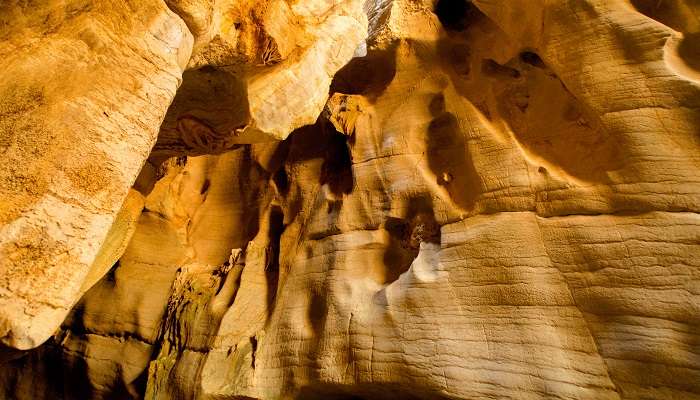
Surrounded by the lush jungles of southwest Cambodia, Phnom Chhngok Cave is a hidden gem that travellers have largely undiscovered. This awe-inspiring cave system in the Cardamom Mountains near the Thai border is a natural wonder that will take your breath away with its striking limestone formations and cavernous underground chambers. But Phnom Chhngok Cave is more than just a geological marvel – it’s also a window into Cambodia’s rich cultural heritage. Local communities have long revered the cave as a sacred site, with ancient carvings and Buddhist shrines found throughout its chambers. Exploring this extraordinary cave is a feast for the eyes and an opportunity to gain insight into the spiritual traditions that have shaped this region for centuries.
About Phnom Chhngok Cave
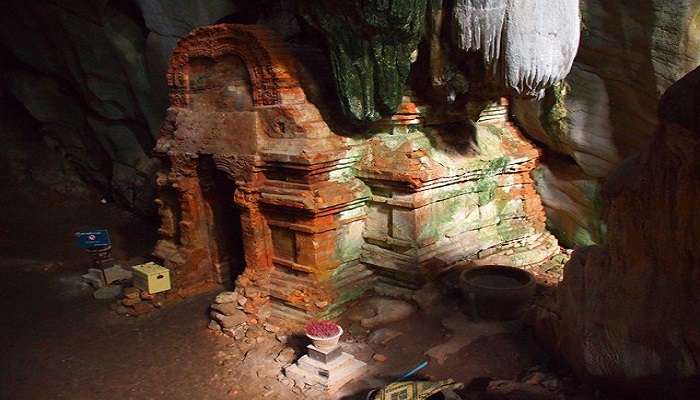
Phnom Chhngok Cave is a unique site in Cambodia as it is the only cave temple. Located near Kampot, it dates back to the 5th-century Funan era. This Phnom Chhngok Cave temple is dedicated to the Hindu god Shiva. It is believed to be one of Cambodia’s oldest monuments, even predating Angkor’s grand structures.
The entrance involves climbing a staircase that leads past a Buddhist shrine and offers a scenic viewpoint. As you descend into the cave, you might encounter a small elephant-shaped monolith before finally reaching the ancient temple. The cave interior is a natural wonder, with stalactites and stalagmites decorating the ceiling.
Must Read: Banteay Srei Cambodia
History Of Phnom Chhngok Cave
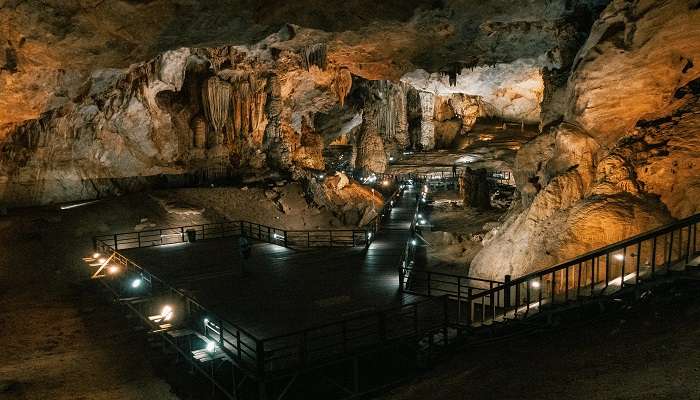
The Phnom Chhngok Cave, also known as Phnom Chhnork Cave Temple, holds a special place in Cambodian history. It predates the grand temples of Angkor Wat. Carved into the Phnom Chhnork mountain, this cave sanctuary boasts a rich past dating back to the 7th century, during the Funan era.
The natural beauty of the cave adds another layer of significance. Stalactites and stalagmites adorn the caverns, some resembling elephants, adding to the mystical atmosphere. The entrance itself is reached by climbing a set of stone steps, leading visitors into the cool depths of the mountain. While historical records about the cave’s specific use are sparse, the temple likely served as a place of pilgrimage and worship during the Funan era. Today, Phnom Chhngok Cave remains an important cultural and religious site, attracting pilgrims and tourists seeking a glimpse into Cambodia’s ancient past.
Top Places To Visit Nearby Phnom Chhngok Cave
When visiting Phnom Chhngok Cave, several other nearby attractions are worth exploring. Some of the top places to visit nearby are as follows:
1. Durian Roundabout
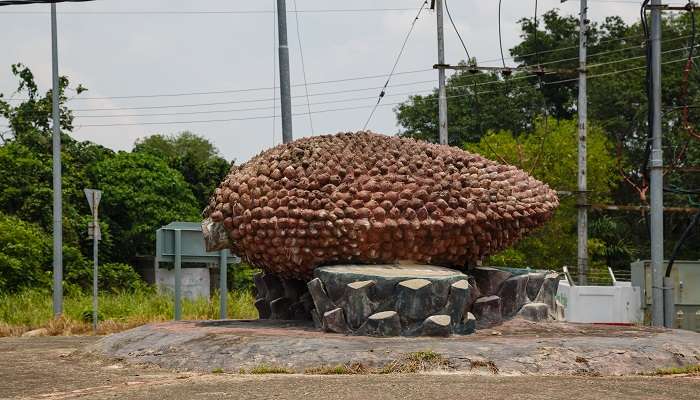
The Durian Roundabout in Kampot, Cambodia, is a unique attraction that celebrates the region’s cultural heritage. Completed in 2016, this circular traffic hub features intricate wood and stone carvings and concrete murals. Local artist Sereyvath Nhean designed the artwork, drawing inspiration from traditional Khmer architecture and the symbolism of the durian fruit. In Cambodian culture, durian represents good fortune, prosperity, and fertility.
Location: J56J+6J, Krong Kampot, Cambodia
Travel Time: 23 minutes
Suggested Read: Neak Paon
2. Bokor Hill Station
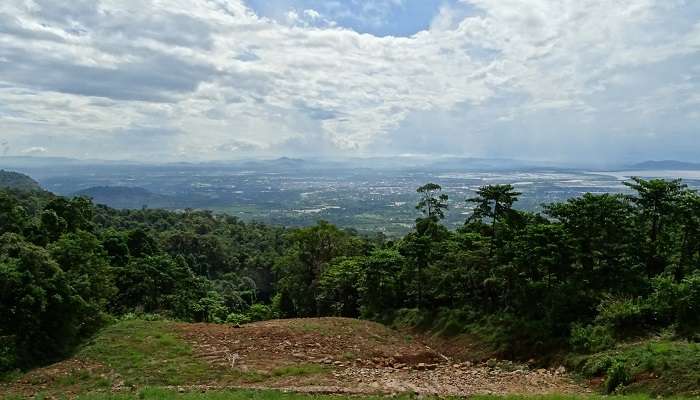
Bokor Hill Station, located atop Bokor Mountain in Preah Monivong National Park was constructed during the 1920s as a French colonial retreat. This temperate mountain luxury resort featured elegant buildings, including the grand Bokor Palace Hotel, a post office, and a Catholic church. Abandoned over time, it has recently become accessible due to modern infrastructure and ongoing redevelopment efforts. Notably, it served as a filming location for movies like “City of Ghosts” (2002) and “R-Point” (2004).
Location: J2CG+XPW, Phumi Pôpôk Vil, Cambodia
Travel Time: 1 Hour 19 minutes
3. Kep National Park
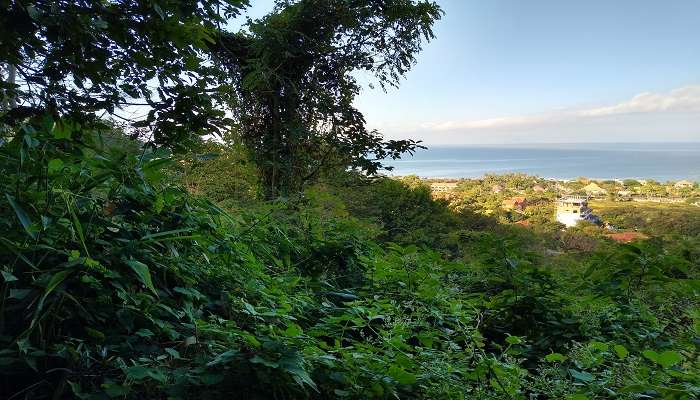
Kep National Park, nestled in Cambodia’s Kep Province, covers an area of 11.52 km². Established in 1993, it features a small mountain range and several hiking trails. From these trails, visitors can enjoy panoramic views of Phu Quoc and the Bokor Ranges to the south and west. Additionally, the park offers glimpses across the islands of the Vietnamese marine reserve in Kiên Giang to the east.
Location: Krong Kaeb, Cambodia
Travel Time: 41 minutes
Suggested Read: Tonle Bati
4. Phnum Bokor National Park
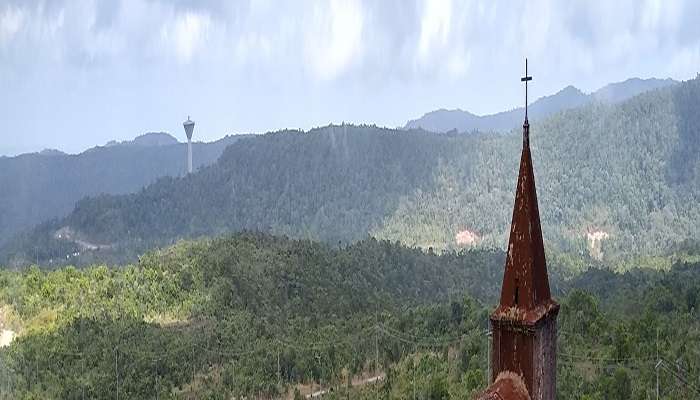
Phnum Bokor National Park, also known as Preah Monivong Bokor National Park, is a captivating natural wonder in Kampot Province. Covering an expansive 1,400 km², it boasts a diverse landscape of mountains, ancient ruins, and remnants of French colonial settlements. The park’s centrepiece is Bokor Hill, rising to 1,048 meters above sea level. Here, you’ll find historical sites like the Black Palace (Damnak Sla Khmao), once a summer residence for King Sihanouk, now adorned with graffiti and surrounded by butterflies. Across the road stands the 29-meter-high Lok Yeay Mao Monument, revered in Buddhist culture.
Location: National Hwy 3, Cambodia
Travel Time: 1 Hour 14 minutes
How To Reach Phnom Chhngok Cave

Reaching Phnom Chhngok Cave involves several travel options depending on your starting point. Some of the ways to reach the Phnom Chhngok Cave are as follows:
By Air
Sihanoukville International Airport is the closest airport to Kampot. You can hire a cab or bus from the airport to reach Kampot.
By Train
A train service operates from Phnom Penh to Kampot. After reaching Kampot, you can hire a taxi or a tuk-tuk to get to the cave temple.
By Road
Taxi is the most convenient option but also the most expensive. You can hail a taxi in Kampot or arrange for one to pick you up from your hotel. The ride to the cave takes about 30 minutes and will cost around $20 for a return trip. You can also hire a Tuk-tuk. They are a fun and affordable way to get around Kampot. You can negotiate a price with a driver to take you to the cave and wait for you while you explore. A round trip should cost around $15.
Further Read: Tonle Sap Lake
Exploring Phnom Chhngok Cave is an amazing experience that reveals Cambodia’s natural beauty. This cave is a hidden gem worth discovering with its stunning rock formations and peaceful atmosphere. Plan your trip to Cambodia and visit this remarkable destination. Make sure to visit Phnom Chhngok Cave. Don’t miss out on creating lasting memories in one of Southeast Asia’s most stunning natural wonders.
For our editorial codes of conduct and copyright disclaimer, please click here.
Cover Image Source: Shutterstock
Frequently Asked Questions About Phnom Chhngok Cave
How old is the Phnom Chhngok Cave temple?
The temple complex is a blend of ages. The brick struct
What can I expect to see there at Phnom Chhngok Cave?
The cave is adorned with impressive stalagmites and stalactites, some resembling elephant shapes (called Phnom Sorsia). Inside the cave, you'll find the remains of the 7th-century temple, including a shrine housing a natural stalactite lingam (a representation of Shiva). There's also a more recent Buddhist presence with additional statues and iconography.
What's the difficulty level for visiting the Phnom Chhngok Cave?
Be aware that the cave can be challenging to navigate. The path can be slippery, there are drops inside, and the lighting is poor. If you're not comfortable with uneven surfaces or low light, it might be best to admire the site from the outside.
Can I take photos inside the Phnom Chhngok Cave?
Yes, photography is allowed. However, flash photography might be disruptive to other visitors and potentially damage the temple. Be mindful of the low light conditions.
What should I do when visiting the Phnom Chhngok Cave?
As it's a religious site, it's best to seek blessings from Lord Buddha and offer your prayers.
People Also Read:
Kedarnath Cave Limestone Caves Lahesh Cave

As a Travel Content Writer, I live to conquer the world of globetrotting with words. With my unquenchable thirst for storytelling, I believe that my words will inspire you to travel around the world’s breathtaking landscapes. As for me, I am an unapologetic selenophile, who loves to wander around in a starry night!











